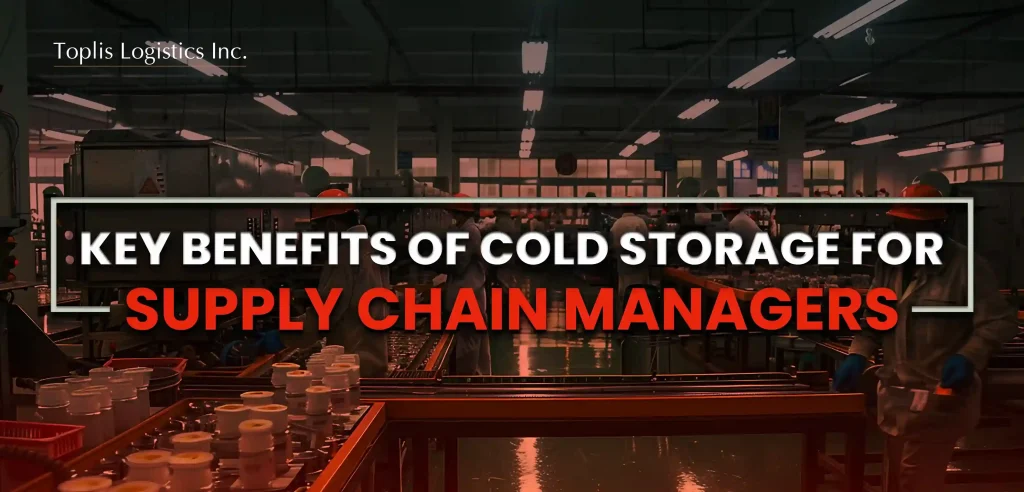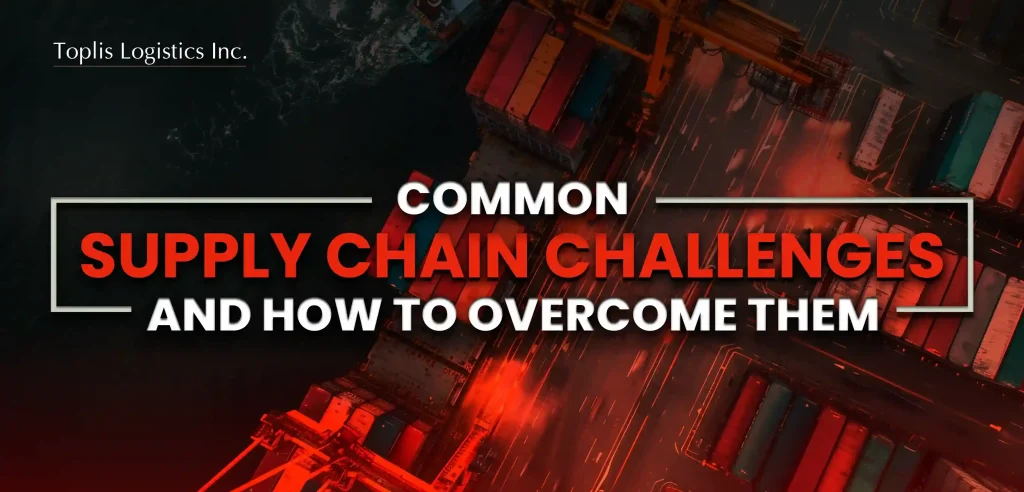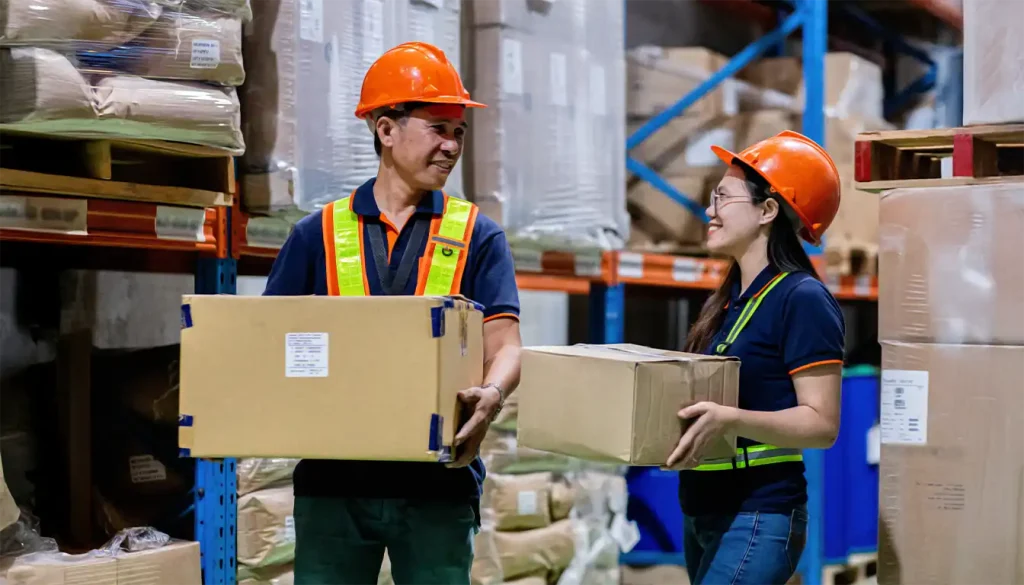Sudden changes in demand, supplier delays, rising shipping costs, and unforeseen natural disasters or political conflicts can disrupt even the best-planned supply chains.
Common examples of supply chain challenges include:
- A spike in online orders may overwhelm your warehouse.
- A key supplier may shut down due to extreme weather.
- Port delays may slow down inter-island shipments.
As technology changes the supply chain, it is important to be ready and set clear goals. This helps you stay competitive and ensures long-term success.
But as a supply chain manager, are you equipped for this shift?
How Supply Chain Managers Can Overcome Common Logistics Challenges
Supply chain managers face constant pressure to resolve supply chain challenges quickly and effectively. These professionals work to improve logistics. They keep inventory under control and collaborate with teams in the supply chain. This helps everything run smoothly.
As a supply chain manager, you have to make quick and smart decisions.
Why? Because challenges in supply chain management will keep growing
With rising customer expectations and growing environmental risks, supply chain managers are turning to logistics service providers for support. So, if you’re constantly racing to solve problems and keep operations stable, you’re not alone.
The good news? There are proven tools and effective strategies that can make a real difference.
In this blog, we’ll explore the challenges, problems, and issues in supply chain management. We will also share practical tips to help you respond faster, avoid major disruptions, and build a stronger and more flexible supply chain—no matter what comes your way.
Table of Contents
- Top 5 Challenges of Supply Chain Management
- Inconsistent Supply and Demand Forecasting
- Inventory Management and Warehousing Bottlenecks
- Logistics and Transportation Issues
- Lack of Integrated Technology Solutions
- Manpower Shortage in Logistics
- Major Problems and Issues Facing By Supply Chain in the Future
- How to Overcome Supply Chain Challenges: Strategic Solutions for Supply Chain Managers
- Apply Demand-Driven Inventory Solutions
- Foster a Strong Relationship with Suppliers
- Invest in Technology Solutions
- Ensure Reliable and Cost-Effective Transportation
- Reinforce Workforce Development and Traning Program
- Conclusion
Top 5 Challenges of Supply Chain Management

1. Inconsistent Supply and Demand Forecasting
Fluctuating customer demands and market trends make it difficult for supply chain managers to accurately forecast supply needs. This can result in either excess inventory or stockouts, both of which can harm profitability and customer satisfaction

2. Inventory Management and Warehousing Bottlenecks
Relying on manual inventory tracking and old systems can cause inefficiencies in warehousing. Without proper supply chain visibility tools, inventory errors and delays are more likely to occur. This often leads to increased operational costs.

3. Logistics and Transportation Issues
Unpredictable delivery times, poor route planning, and rising transportation costs are major pain points for supply chain managers. These issues disrupt delivery timelines and strain customer relationships.

4. Lack of Integrated Technology Solutions
Many supply chains rely on fragmented software or manual systems that no longer work together. This lack of integration makes it hard to get real-time insights and slows down decision-making.
These are platforms that offer end-to-end visibility and control across the supply chain:
SAP Integrated Business Planning (IBP)
A cloud-based solution that supports real-time planning, inventory optimization, and supply planning
Oracle SCM Cloud
A comprehensive suite that covers procurement, logistics, product lifecycle, and order management with built-in AI features.
Microsoft Dynamics 365 Supply Chain Management
Offers real-time tracking of inventory, production, and warehouse operations to improve decision-making.
Infor Nexus
A network-based platform that connects global supply chain partners for improved collaboration and supply chain visibility.

5. Manpower Shortage in Logistics
A shortage of skilled labor and high employee turnover negatively affect warehouse productivity and service levels. Without a dependable workforce partner, supply chain managers often deal with costly delays and operational disruptions.

Cold Storage Solutions for Businesses in the Philippines
Toplis Logistics provides a diverse range of cold storage warehouses, each catering to different temperature zones, for commercial and industrial use.
Major Problems and Issues Facing By Supply Chain in the Future
Global supply chains often involve multiple stakeholders across different regions, making coordination more challenging. This complexity can raise costs and increase the risk of delays for not following international regulations.
With growing consumer demand for eco-friendly practices, companies are expected to adopt greener operations. However, shifting to sustainable technologies and processes can require large investments, which many organizations find difficult to manage.
Automation and AI can greatly improve efficiency. However, they also need a skilled workforce to operate them. Many companies face a skills gap between current employee capabilities and the technical skills needed for future operations.
Ongoing political conflicts and trade disputes between countries can disrupt supply chains by causing delays, restrictions, or shifts in trade policies. These tensions make it harder to maintain consistent supplier relationships and secure reliable equipment and materials sourcing.
Market fluctuations, inflation, and global financial instability create unpredictable business environments. To stay competitive, your business must remain proactive,, adaptable, and ready to respond to sudden economic shifts.
How to Overcome Supply Chain Challenges: Strategic Solutions for Supply Chain Managers
As a supply chain manager, handling complex challenges is part of your daily responsibilities. To manage these effectively, it’s important to take a proactive approach using clear and strategic steps.
Below are some of the solutions that you can apply to streamline your supply chain process.
Apply Demand-Driven Inventory Solutions
Enhancing visibility across the supply chain can significantly mitigate risks. Implementing advanced tracking technologies and data analytics tools allows you to monitor inventory levels, shipment statuses, and supplier performance in real-time.
This transparency enables quicker decision-making and helps identify potential bottlenecks before they escalate.
Foster a Strong Relationship with Suppliers
Keeping clear and consistent communication with your equipment and materials suppliers ensures a better alignment in product quality expectations and delivery timelines. This collaboration builds a stronger relationship, sustains a more reliable service, and provides flexibility when unexpected challenges arise.
Additionally, working with a wide range of suppliers can protect your supply chain from location-based or market-related disruptions. By getting supplies from different vendors or areas, you lower your dependence on one source. This helps you adapt better when unexpected problems arise.
Invest in Technology Solutions
Adding technology-based solutions to your strategy can improve demand planning accuracy. By leveraging predictive analytics, you can anticipate fluctuations more effectively and adjust procurement strategies accordingly.
“Advanced technologies are shaking up the supply chain world. With quickly evolving capabilities across generative AI, data analytics, automation, machine learning, Internet of Things (IoT), blockchain and more, the ‘smart’ supply chain is well on its way to becoming the new normal.” – KPMG International
With well-placed warehouses and modern warehouse management systems (WMS), your business can fulfill orders faster. This also helps with better storage and accurate stock tracking.
Ensure Reliable and Cost-Effective Transportation
With uncontrollable oil price hikes, ensuring timely deliveries has become essential to minimizing production and transportation costs. This challenge presents an opportunity to partner with a reliable logistics service provider that operates a nationwide fleet and leverages advanced route optimization tools.
By doing so, you can streamline business operations and reduce fuel consumption, which then leads to reducing transportation costs.
Reinforce Workforce Development and Traning Program
A reliable logistics manpower provider gives you quick access to skilled workers exactly where and when you need them. They offer tailored workforce solutions, including specialized training, strong safety practices, and flexible staffing options that fit your specific operational needs.
By applying these strategies, you’ll be better prepared to handle supply chain challenges while keeping your operations running smoothly.

Key Benefits of Cold Storage for Supply Chain Managers
Discover the benefits of cold storage and how it enhances supply chain efficiency. Learn the proper temperature control and planning strategies every supply chain manager should know.
Why Supply Chain Managers Trust Toplis Logistics
Toplis Logistics has a proven track record of being the best logistics provider in the Philippines as we consistently deliver end-to-end logistics solutions from manufacturing to retail sectors. With modern tools and deep industry knowledge, we help businesses solve common logistics problems.
Our ISO-certified processes, commitment to innovation, and customer-centric approach make us the go-to partner for supply chain managers looking to improve performance and reduce operational risks.
This helps you focus on bigger goals. Including improving your business strategy and creating a better experience for customers.
Conclusion
Supply chain managers face many challenges. These include changing market demands, rising oil prices, and old systems. All of these create problems in operations.
To stay ahead, supply chain managers must invest in real-time tracking systems, use data to predict and plan for market demands, build strong relationships with multiple suppliers, and develop backup plans for potential disruptions.
But, most importantly, establish partnerships with a trusted logistics partner.
To streamline your supply chain and gain a competitive edge, partner with Toplis Logistics. This strategy can ensure on-time deliveries. It will also help you keep efficiency and profit during economic inflation.
Frequently Asked Questions
A process of overseeing and improving how a company produces and delivers its products or services. It covers every step—from sourcing raw materials to making the final product and getting it to the customer.
Fluctuating market demands, supplier delays, rising shipping costs, and unforeseen natural disasters or political conflicts are some of the key issues in supply chain management.
A software that manages and controls all aspects of warehouse operations, from receiving goods to shipping them to customers. This helps mitigate warehousing problems and avoids operational disruptions.




